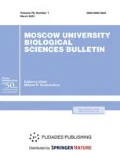Abstract
We studied the effect of the histidine-containing dipeptide carnosine in the norm and under hypoxia conditions on the conditioned passive avoidance response in a three-compartment chamber, which consisted of a light compartment, a dark dangerous compartment where the rat received a foot shock, and a dark safety compartment, where the rat did not receive a foot shock. We found that carnosine normalized physiological indices, which were impaired by acute exposure to hypobaric hypoxia, and increased the number of choices of the safety compartment in both intact rats and rats subjected to hypoxia.
Similar content being viewed by others
References
Gulewitch, W.S. and Amiradzibi, S., Uber das Carnosin, eine neue organische Base des Fleischextraktes, Ber. Deutsch Chem. Ges., 1900, vol. 33, pp. 1900–33.
Boldyrev, A.A., Karnozin (Carnosine), Moscow: Izd. Mosk. Gos. Univ., 1998.
Hipkiss, A.R., Cartwright, S.P., Bromley, C., Gross, S.R., and Bill, R.M., Carnosine: can understanding its actions on energy metabolism and protein homeostatis inform its therapeutic potential?, Chem. Cent. J., 2013, vol. 7, pp. 2013–7.
Boldyrev, A.A., Carnosine: a new concept for the function of an old molecule, Biochemistry (Moscow), 2013, vol. 77, no. 4, pp. 313–326.
Gulyaeva, N.V., Prospects of creating drugs based on carnosine (some new principles), Biokhimiya, 1992, vol. 57, no. 9, pp. 1398–1403.
Rumyantseva, S.A., Fedin, A.I., Bolevich, S.B., and Silina, E.V., Free-radical processes and their correction in hemorrhagic stroke, Nevrol. Zh., 2007, vol. 12, no. 5, pp. 51–56.
Federico, A., Cardaioli, E., Da, Pozzo P., Formichi, P., Gallus, G., and Radi, E., Mitochondia, oxidative stress and neurodegeneration, J. Neurol. Sci., 2012, vol. 322, no. 1, pp. 254–262.
Yan, M., Wang, X., and Zhu, X., Mitochondrial defects and oxidative stress in Alzheimer disease and Parkinson disease, Free Radic. Biol. Med., 2012, vol. 62, pp. 2012–62.
Boldyrev, A.A., Stvolinskii, S.L., and Fedorova, T.N., Carnosine: endogenous physiologic corrector of the activity of antioxidant systems of the body, Usp. Fiziol. Nauk, 2007, vol. 38, no. 3, pp. 57–71.
Dobrotvorskaya, I.S., Fedorova, T.N., Dobrota, D., and Berezov, T.T., Characteristics of oxidative stress in experimental rat brain ischemia aggravated by homocysteic acid, Neurochem. J., 2011, vol. 5, no. 1, pp. 42–46.
Suslina, Z.A., Maksimova, M.Yu., and Fedorova, T.N., Oxidative stress and the main directions of neuroprotection in cerebral circulation disorders, Nevrol. Zh., 2007, vol. 12, no. 4, pp. 1–5.
Dobrota, D., Fedorova, T., Stepanova, M., Babusikova, E., Statelova, D., Tatarkova, Z., Stvolinsky, S., and Boldyrev, A., Oxidative stress, induced in rat brain by a combination of 3-nitropropionic acid and global ischemia, J. Clin. Exp. Med., 2010, vol. 3, no. 2, pp. 144–152.
Stvolinsky, S., Toropova, K., and Gordeeva, M., Carnosine and its (S)-Trolox derivative protect animals against oxidative stress, Amino Acids, 2012, vol. 43, no. 1, pp. 165–170.
Gallant, S., Kukley, M., Stvolinsky, S., Bulygina, E., and Boldyrev, A., Effect of carnosine on rats under experimental brain ischemia, Tohoku J. Exp. Med., 2000, vol. 191, no. 2, pp. 85–99.
Inozemtsev, A.N., Berezhnoy, D.S., Fedorova, T.N., and Stvolinsky, S.L., The effect of the natural dipeptide carnosine on learning of rats under the conditions of negative reinforcement, Dokl. Biol. Sci., 2014, vol. 454, pp. 2014–454.
Voronina, T.A. and Ostrovskaya, R.U., Guidelines for the study of nootropic activity of pharmacological substances, in Rukovodstvo po eksperimental’nomu (doklinicheskomu) izucheniyu novykh farmakologicheskikh veshchestv (Manual on Experimental (Preclinical) Study of New Pharmacological Substances), Khabriev, R.U., Ed., Moscow: Remedium, 2000, pp. 153–158.
Stuchlik, A., Petrasek, T., Prokopova, I., Holubova, K., Hatalova, H., Vales, K., Kubik, S., Dockery, C., and Wesierska, M., Place avoidance tasks as tools in the behavioral neuroscience of learning and memory, Physiol. Res., 2013, vol. 12, suppl. 1, pp. 1–19.
Inozemtsev, A.N., Kapitsa, I.G., Garibova, T.L., Bokieva, S.B., and Voronina, T.A., Comparison of the effect of nootropics and anxiolytics on the functional disorders of the avoidance response, Vestn. Mosk. Univ., Ser. 16: Biol., 2004, no. 3, pp. 24–30.
Inozemtsev, A.N. and Pragina, L.L., Methodological stressogenic approaches to study the effects of nootropic agents on learning and memory, Vestn. Mosk. Univ., Ser. 16: Biol., 1992, no. 4, pp. 23–31.
Inozemtsev, A.N., Biological origins of protective mechanisms activated by the disruption of higher nervous activity, Moscow Univ. Biol. Sci. Bull., 2009, vol. 64, no. 2, pp. 57–62.
Inozemtsev, A.N., Bel’nik, A.P., and Ostrovskaya, R.U., Study of the conditioned reflex of passive avoidance in a modified three-chamber box, Eksp. Klin. Farmakol., 2007, no. 2, pp. 67–69.
Inozemtsev, A.N., Analysis of the memory trace nature in passive avoidance response, Moscow Univ. Biol. Sci. Bull., 2013, vol. 68, no. 2, pp. 53–57.
Agadzhanyan, N.A. and Elfimov, A.I., Funktsii organizma v usloviyakh gipoksii i giperkapnii (Body Functions Under Conditions of Hypoxia and Hypercapnia), Moscow: Meditsina, 1986.
Inozemtsev, A.N. and Serkov, A.N., Development of the conditioned response of passive avoidance in rats, in Bol’shoi praktikum po vysshei nervnoi deyatel’nosti i neirofiziologii. Uchebnoe posobie (Greater Practical Course in Higher Nervous Activity and Neurophysiology).
Author information
Authors and Affiliations
Corresponding author
Additional information
Original Russian Text © D.S. Berezhnoy, S.B. Bokieva, S.L. Stvolinskii, T.N. Fedorova, A.N. Inozemtsev, 2015, published in Vestnik Moskovskogo Universiteta. Biologiya, 2015, No. 3, pp. 3–7.
About this article
Cite this article
Berezhnoy, D.S., Bokieva, S.B., Stvolinskii, S.L. et al. Effect of carnosine on conditioned passive avoidance response in the norm and under hypoxia conditions. Moscow Univ. Biol.Sci. Bull. 70, 105–109 (2015). https://doi.org/10.3103/S0096392515030037
Published:
Issue Date:
DOI: https://doi.org/10.3103/S0096392515030037


